

 |
 |
| Grammar Stage | Copybook Resources | Dialectic Stage | Rhetoric Stage |
IN ASSOCIATION WITH |
Click on each title cover to review price and availabilty; and to place an order. |
Grammar Stage Writing: Grades 1-6
1st Grade: mastering print letter formation (learned in conjunction with learning to read)
The Writing Road to
Reading
Romalda Spaulding
 The Writing Road to Reading method is based on the phonetics
research of Dr. Samuel T. Orton, on which most modern scientific-approach phonics
instruction is also based. Bound into the book are seventy phonogram cards designed to be
detached and used for instruction and drill. A recording of the phonograms is also
included, to ensure correct pronunciation. WRTR integrates phonics, reading, penmanship,
and spelling instruction in this one book--children learn the phonograms while writing
them, seeing them, and hearing them spoken. The penmanship
instruction for teaching letter formation is the best I have ever seen. The
program is so well-designed that dyslexia is often arrested before it has a chance to
become established. CCH highly recommends one of the WRTR teacher’s guides--either Teaching Reading at Home by Wanda Sanseri, or Teacher’s Edition with Annual Lesson Plans
by Myrna McCulloch, for help in implementing the program. WRTR is CCH’s top choice
for orthography instruction.
The Writing Road to Reading method is based on the phonetics
research of Dr. Samuel T. Orton, on which most modern scientific-approach phonics
instruction is also based. Bound into the book are seventy phonogram cards designed to be
detached and used for instruction and drill. A recording of the phonograms is also
included, to ensure correct pronunciation. WRTR integrates phonics, reading, penmanship,
and spelling instruction in this one book--children learn the phonograms while writing
them, seeing them, and hearing them spoken. The penmanship
instruction for teaching letter formation is the best I have ever seen. The
program is so well-designed that dyslexia is often arrested before it has a chance to
become established. CCH highly recommends one of the WRTR teacher’s guides--either Teaching Reading at Home by Wanda Sanseri, or Teacher’s Edition with Annual Lesson Plans
by Myrna McCulloch, for help in implementing the program. WRTR is CCH’s top choice
for orthography instruction.
Discover
Intensive Phonics For Yourself
Charlotte Lockhart
A very impressive scientific-approach phonics program, based on Dr. Orton’s research. Divided into 77 lessons, each thoroughly explained, this program progresses step-by-step through the 42 sounds of the alphabet, the five phonetic skills, and the two-step decoding system that picks up where a lot of phonics instruction leaves off, by teaching children how to decode multiple syllable words. Penmanship instruction is included. The kit comes with a pronunciation tape.
2nd-3rd Grades: mastering script penmanship
Theory of Spencerian
Penmanship
Spencerian Authors
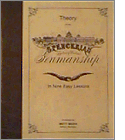 Platt
Spencer writes of the importance of penmanship: “Writing is almost as important as
speaking, as a medium for communicating thought. For this reason it is said that
“Writing is a secondary power of speech, and they who cannot write are in part
dumb.” Scrawls that cannot be read may be compared to talking that cannot be
understood; and writing difficult to decipher, to stammering speech. Theory directs, and
Art performs; therefore inform the mind and train the hand. If you would attain high
excellence in Penmanship, you must master the principles, and faithfully practice
them.” His book of Theory teaches the principles of penmanship in nine lessons: how
to sit and hold a pen, the individual movements and forms that make up script penmanship,
all the lower-case and capital letters, and numbers. The Theory is meant to be used in
conjunction with the Spencerian Copybooks, which provide the practice of the theory. The
lower-case letters are identical to modern cursive, while the capitals are easy to read
and elegant. The advantage is the teaching of the principles of penmanship so that
children have the necessary tools to produce neat and legible script.
Platt
Spencer writes of the importance of penmanship: “Writing is almost as important as
speaking, as a medium for communicating thought. For this reason it is said that
“Writing is a secondary power of speech, and they who cannot write are in part
dumb.” Scrawls that cannot be read may be compared to talking that cannot be
understood; and writing difficult to decipher, to stammering speech. Theory directs, and
Art performs; therefore inform the mind and train the hand. If you would attain high
excellence in Penmanship, you must master the principles, and faithfully practice
them.” His book of Theory teaches the principles of penmanship in nine lessons: how
to sit and hold a pen, the individual movements and forms that make up script penmanship,
all the lower-case and capital letters, and numbers. The Theory is meant to be used in
conjunction with the Spencerian Copybooks, which provide the practice of the theory. The
lower-case letters are identical to modern cursive, while the capitals are easy to read
and elegant. The advantage is the teaching of the principles of penmanship so that
children have the necessary tools to produce neat and legible script.
Spencerian
Copybook 1
Spencerian Authors
2nd grade, or beginning script practice. This copybook introduces all the short lower-case letters. Only four strokes, or principles as Spencer called them, are needed to produce these letters.
Spencerian
Copybook 2
Spencerian Authors
2nd grade, or following Copybook 1. This copybook adds the tall lower-case letters--t and d--to those already learned, and the numbers 1 through 9.
Spencerian
Copybook 3
Spencerian Authors
2nd or 3rd grade, or following Copybook 2. This copybook completes the lower-case alphabet and introduces most of the capitals.
Spencerian
Copybook 4
Spencerian Authors
3rd grade, or following Copybook 3. This copybook completes the capital alphabet and provides practice on all the letters as they combine to form words.
Spencerian
Copybook 5
Spencerian Authors
3rd grade, or following Copybook 4. This copybook presents sentences for writing practice, such as: Kind words never die, and Promise little and do much.
Return to Writing Index
Grammar Stage Copybook Resources
Copying should be practiced daily, as soon as the print alphabet is learned. Even while learning script in 2nd-3rd grades of the grammar stage; continue working on copying selections daily--just continue to do so in print, until the enough of the script alphabet is learned in order to begin copybook in script. Your child’s copybook can be anything from a penmanship tablet to a spiral notebook to notebook paper in a binder, to a beautifully bound writing journal. In the later grades of the grammar stage (5th-6th grades) it would be good to practice some of the copybook selections as dictation. Especially for children beginning dictation, it might be wise to have the child copy the passage one day, and then write it from dictation the next. More and more dictation can be included until by the end of sixth grade, all or almost all of your child’s copybook selections are written from dictation.
It is not necessary to purchase every copybook resource listed here right away. A child writing in their copybook daily will need lots and lots of material to copy from in the course of six years, and new resources can be purchased when current ones have been exhausted. Also, some of the very highest quality resources are out of print, and the other in-print resources can be used if they cannot be found.
 It would
greatly benefit every child to copy as much of the Bible as possible during the grammar
stage. There is no greater material on which to practice penmanship and learn writing
mechanics. Our favorite books of the Bible for copying include the Psalms and Proverbs;
Genesis, Isaiah, the gospels, Romans, I & II Corinthians, Galatians, Ephesians,
Philippians, Colossians, and Hebrews, but of course, any and all Scripture is edifying and
useful for copying. Use the family Bible or one of
these resources:
It would
greatly benefit every child to copy as much of the Bible as possible during the grammar
stage. There is no greater material on which to practice penmanship and learn writing
mechanics. Our favorite books of the Bible for copying include the Psalms and Proverbs;
Genesis, Isaiah, the gospels, Romans, I & II Corinthians, Galatians, Ephesians,
Philippians, Colossians, and Hebrews, but of course, any and all Scripture is edifying and
useful for copying. Use the family Bible or one of
these resources:
A Giant Print Bible is
easier for beginning readers and writers in 1st through 3rd grades to read and copy from.
The Ultrathin Reference Bible
is CCH’s top choice for older children in 4th grade and up, developing personal
consistent Bible-reading habits, to own and use in school when they ougrow their
“little kid” Bibles.
The Elson Primary and
Grammar School Readers
William Elson, Christine Keck; published by Scott, Forseman & Co;
copyright 1909-1913
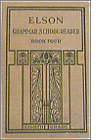 Even though these excellent
readers are out of print, they are CCH’s next choice for copybook material, far and
above any other in-print resources that we have ever seen, and are well worth hunting for.
I like readers for copying from because the material is arranged in graded sections, which
keep pace with a child’s developing vocabulary and reading and writing skills.
However, so many readers are full of just useless, insipid twaddle--but not so in this
case. In the editors’ introduction, they state: “To discriminating teachers it
will be apparent that this book is not the usual school reader. On the contrary, it
differs widely from this in the cultural value of the selections, in the classification
and arrangement of material, in the variety of interest to which it appeals, and in the
abundance of classic literature from English and American authors which it contains. It
aims to furnish the best in poetry and prose to be found in the literature of the
English-speaking race and to furnish it in abundance. If these familiar old selections,
long accepted as among the best in literature, shall be the means of cultivating in pupils
a taste for good reading, the book will have fulfilled its purpose.” A word of
caution is in order: William Gray, one of the great proponents of the whole-word, look-say
reading method, eventually was hired by Scott Forseman in the 30’s to dumb-down the
Elson Readers, and the result was the Elson-Gray Readers, or Basic Readers. Avoid
these--almost none of the material is the same. What was appropriate reading material for
a sixth grader in the Elson Grammar School Readers (the stories of Odysseus, Achilles,
Aeneas, and Horatius; essays by Franklin, Dickens, and Emerson; poetry by Wordsworth,
Whittier, Addison, Longfellow, Tennyson, and Holmes) is no where found in the weak
selections in the Elson-Gray Sixth Reader. Incidently, William Gray went on to develop the
Dick and Jane readers for Scott Forseman, and our nation’s literacy rate has been
plunging ever since.
Even though these excellent
readers are out of print, they are CCH’s next choice for copybook material, far and
above any other in-print resources that we have ever seen, and are well worth hunting for.
I like readers for copying from because the material is arranged in graded sections, which
keep pace with a child’s developing vocabulary and reading and writing skills.
However, so many readers are full of just useless, insipid twaddle--but not so in this
case. In the editors’ introduction, they state: “To discriminating teachers it
will be apparent that this book is not the usual school reader. On the contrary, it
differs widely from this in the cultural value of the selections, in the classification
and arrangement of material, in the variety of interest to which it appeals, and in the
abundance of classic literature from English and American authors which it contains. It
aims to furnish the best in poetry and prose to be found in the literature of the
English-speaking race and to furnish it in abundance. If these familiar old selections,
long accepted as among the best in literature, shall be the means of cultivating in pupils
a taste for good reading, the book will have fulfilled its purpose.” A word of
caution is in order: William Gray, one of the great proponents of the whole-word, look-say
reading method, eventually was hired by Scott Forseman in the 30’s to dumb-down the
Elson Readers, and the result was the Elson-Gray Readers, or Basic Readers. Avoid
these--almost none of the material is the same. What was appropriate reading material for
a sixth grader in the Elson Grammar School Readers (the stories of Odysseus, Achilles,
Aeneas, and Horatius; essays by Franklin, Dickens, and Emerson; poetry by Wordsworth,
Whittier, Addison, Longfellow, Tennyson, and Holmes) is no where found in the weak
selections in the Elson-Gray Sixth Reader. Incidently, William Gray went on to develop the
Dick and Jane readers for Scott Forseman, and our nation’s literacy rate has been
plunging ever since.
There are eight readers altogether, for first through eighth grades. The four Primary School Readers can be used throughout grades 1 through 3, and the four Grammar School Readers can be used throughout grades 4 through 6. Or, use each grade’s book for that grade’s copywork, and use Grammar School Readers books three and four for 7th and 8th grade dictation, in addition to the 7th and 8th grade writing work of learning to write sentences and paragraphs.
Elson Primary School Reader Book I
for 1st grade.
Out of print. Search BookFinder.com, Bibliofind,
or Barnes
& Noble Out of Print Books via an author search using ‘William Elson,’
and a title search using ‘Primary One.’
Elson Primary School Reader Book II
for 2nd grade.
Out of print. Search BookFinder.com, Bibliofind,
or Barnes
& Noble Out of Print Books via an author search using ‘William Elson,’
and a title search using ‘Primary Two.’
Elson Primary School Reader Book III
for 3rd grade.
Out of print. Search BookFinder.com, Bibliofind,
or Barnes
& Noble Out of Print Books via an author search using ‘William Elson,’
and a title search using ‘Primary Three.’
Elson Primary School Reader Book IV
for 4th grade.
Out of print. Search BookFinder.com, Bibliofind,
or Barnes
& Noble Out of Print Books via an author search using ‘William Elson,’
and a title search using ‘Primary Four.’
Elson Grammar School Reader Book I
for 5th grade.
Out of print. Search BookFinder.com, Bibliofind,
or Barnes
& Noble Out of Print Books via an author search using ‘William Elson,’
and a title search using ‘Grammar One.’
Elson Grammar School Reader Book II
for 6th grade.
Out of print. Search BookFinder.com, Bibliofind,
or Barnes
& Noble Out of Print Books via an author search using ‘William Elson,’
and a title search using ‘Grammar Two.’
Elson Grammar School Reader Book III
for 7th grade.
Out of print. Search BookFinder.com, Bibliofind,
or Barnes
& Noble Out of Print Books via an author search using ‘William Elson,’
and a title search using ‘Grammar Three.’
Elson Grammar School Reader Book IV
for 8th grade.
Out of print. Search BookFinder.com, Bibliofind,
or Barnes
& Noble Out of Print Books via an author search using ‘William Elson,’
and a title search using ‘Grammar Four.’
The Original
McGuffey’s Eclectic Primers & Readers
William McGuffey; published by Mott Media
This set of graded readers is the original McGuffey’s series so
popular in the 19th century. McGuffey believed that the content of reading matter should
promote moral growth, with abundant Biblical selections; that students should learn to
read, spell, and write using phonics; that memorizing developed the habit of attention
which promoted understanding and mastery of all learning; and that a wide vocabulary would
be the result of such a cultivated mind. This set includes:
the Primer and Pictorial Primer, for copybook in 1st grade;
the First Reader, for copybook in the 2nd grade;
the Second Reader, for copybook in the 3rd grade;
the Third and Fourth Readers, for copybook in the 4th through 6th grades, and dictation in
the dialectic stage.
It also comes with the Eclectic Progressive Spelling
Book, which can be used to teach spelling by syllables in all 6 grades.
The
Christian Eclectic Readers
William McGuffey, Charles & Betty Burger
 This set
is a newly revised edition of McGuffey’s Readers, based on the Original Readers like
the ones above from Mott Media, but with these changes: the editors removed what they
considered “graphic and gruesome details that serve no purpose today but were
commonplace then,” and they also eliminated some “selections that were
moralistic but not specifically Christian.” This set includes:
This set
is a newly revised edition of McGuffey’s Readers, based on the Original Readers like
the ones above from Mott Media, but with these changes: the editors removed what they
considered “graphic and gruesome details that serve no purpose today but were
commonplace then,” and they also eliminated some “selections that were
moralistic but not specifically Christian.” This set includes:
the First Reader, for copybook in the 2nd grade;
the Second Reader, for copybook in the 3rd grade;
the Third and Fourth Readers, for copybook in the 4th through 6th grades, and dictation in
the dialectic stage.
It also comes with the Eclectic Study Guide by Betty Burger, which contains lesson plans
and ideas for teaching literature through the 10th grade using the Christian Eclectic
Readers.
The Harp & the
Laurel Wreath
Laura Berquist
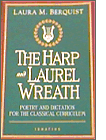 Subtitled: Poetry and Dictation for the Classical Curriculum. This new book contains all
the poetry selections recommended in Berquist’s Designing
Your Own Classical Curriculum, as well as dictation selections designed to improve
the development of a child’s writing ability. The selections are arranged by level:
Primary, for grades 1-3; Gammatical, for grades 4-6; Dialectical, for grades 7-9, and
Rhetorical, for grades 10-12. Approximately 50-75 mostly poetical selections per level.
The Amazon order page says this book is still on order from the publisher, but that should
change momentarily, as CCH has already received a copy from the publisher.
Subtitled: Poetry and Dictation for the Classical Curriculum. This new book contains all
the poetry selections recommended in Berquist’s Designing
Your Own Classical Curriculum, as well as dictation selections designed to improve
the development of a child’s writing ability. The selections are arranged by level:
Primary, for grades 1-3; Gammatical, for grades 4-6; Dialectical, for grades 7-9, and
Rhetorical, for grades 10-12. Approximately 50-75 mostly poetical selections per level.
The Amazon order page says this book is still on order from the publisher, but that should
change momentarily, as CCH has already received a copy from the publisher.
Poetry Selections from the 1000 Good Books list
Poetry should hold a special place in the classical curriculum. Grammar
stage children should hear it read to them, read it, memorize it, copy it in writing
class, and be exposed to it in any other way a parent can conceive of. Poetry is filled
with salient beauty, and not only does it enlarge our vocabulary and give us a deeper
familiarity and appreciation for the subtleties of our language, but it enlarges our
hearts as well.
The Complete Poems of Winnie-the-Pooh and A Child’s Garden of Verses for copybook in 1st
grade;
A Child’s Treasury of Poems for copybook in 2nd
grade;
Favorite Poems Old & New for copybook in 3rd grade;
Best-Loved Poems of the American People for copybook in 4th
grade;
Henry Wadsworth Longfellow for copybook in 5th grade;
New Oxford Book of Christian Verse for copybook in 6th
grade.
By These Words
Paul Angle
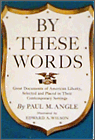 Subtitled: Great Documents of American
Liberty, Selected and Placed in Their Contemporary Settings. This book presents the most
important of our documents as they should be read--against a vivid narrative that
recreates the scene in which each paper was born, describes the people who were there, and
explains why the document came into being. This book is important because of the quality
of documents chosen--there is much more than just the Declaration and the Constitution,
although those are included also. It includes the full text of the Mayflower Compact, the
Fundamental Orders of Connecticut, Liberty is Not License by Roger Williams, Concessions
and Agreements of West Jersey by William Penn, Andrew Hamilton’s Argument by Peter
Zender (fighting for the freedom of the press in 1735), Speech Against the Writs of
Assistance (denouncing tyranny) by James Otis, Resolutions of the Stamp Act Congress, and
36 other important speeches and documents that have shaped our country up to
Eisenhower’s administration. For 4th grade and up copywork and dictation.
Subtitled: Great Documents of American
Liberty, Selected and Placed in Their Contemporary Settings. This book presents the most
important of our documents as they should be read--against a vivid narrative that
recreates the scene in which each paper was born, describes the people who were there, and
explains why the document came into being. This book is important because of the quality
of documents chosen--there is much more than just the Declaration and the Constitution,
although those are included also. It includes the full text of the Mayflower Compact, the
Fundamental Orders of Connecticut, Liberty is Not License by Roger Williams, Concessions
and Agreements of West Jersey by William Penn, Andrew Hamilton’s Argument by Peter
Zender (fighting for the freedom of the press in 1735), Speech Against the Writs of
Assistance (denouncing tyranny) by James Otis, Resolutions of the Stamp Act Congress, and
36 other important speeches and documents that have shaped our country up to
Eisenhower’s administration. For 4th grade and up copywork and dictation.
Out of print. Search BookFinder.com, Bibliofind,
or Barnes
& Noble Out of Print Books via an author search using ‘Paul Angle,’ and
a title search using ‘By These Words.’
The World’s
Famous Orations
William Jennings Bryan, editor; Funk & Wagnalls, publisher;
copyright 1906
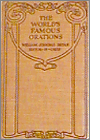 A wonderful little ten volume
set of the best orations produced by Western Civilization, from Greece to America. Not
only are the great political and military speeches included, but also the great sermons of
Western Civilization: Augustine, Chrysostom, Abelard, Bernard, Zwingli, Luther,
Melanchthon, Calvin (On Suffering Persecution), Newman, Spurgeon (Men Made Rich by the
Poverty of Christ) and more. The volumes are arranged more or less chronologically, and
the speeches within each volume are also arranged chronologically: Volume I - Greece,
Volume II - Rome, Volume III-V Great Britain (from the fall of Rome), Volume VI - Ireland,
Volume VII - Continental Europe (from the fall of Rome), Volume VIII-X - America. Speeches
by Pericles, Demosthenes, Hannibal, Caius Marius (my favorite), Cicero, and down the line
to More, Macauley, Goldstone, Burke, Washington, Napoleon, Webster, Lincoln, and many,
many, many more. For 4th grade and up copywork and dictation. The introduction to the set
in the first volume is an essay on oratory by William Jennings Bryan that is really,
really good also--a rhetoric stage student would benefit in studying it.
A wonderful little ten volume
set of the best orations produced by Western Civilization, from Greece to America. Not
only are the great political and military speeches included, but also the great sermons of
Western Civilization: Augustine, Chrysostom, Abelard, Bernard, Zwingli, Luther,
Melanchthon, Calvin (On Suffering Persecution), Newman, Spurgeon (Men Made Rich by the
Poverty of Christ) and more. The volumes are arranged more or less chronologically, and
the speeches within each volume are also arranged chronologically: Volume I - Greece,
Volume II - Rome, Volume III-V Great Britain (from the fall of Rome), Volume VI - Ireland,
Volume VII - Continental Europe (from the fall of Rome), Volume VIII-X - America. Speeches
by Pericles, Demosthenes, Hannibal, Caius Marius (my favorite), Cicero, and down the line
to More, Macauley, Goldstone, Burke, Washington, Napoleon, Webster, Lincoln, and many,
many, many more. For 4th grade and up copywork and dictation. The introduction to the set
in the first volume is an essay on oratory by William Jennings Bryan that is really,
really good also--a rhetoric stage student would benefit in studying it.
Out of print. Search BookFinder.com, Bibliofind,
or Barnes
& Noble Out of Print Books via an author search using ‘William Bryan,’
and a title search using ‘World’s Famous Orations.’
Return to Writing Index
Dialectic Stage Writing: Grades 7-9
Warriner’s
English Composition and Gammar
John Warriner
 This excellent reference can be used throughout all three years of the
dialectic to teach writing. It thoroughly covers grammar in detail, which provides a nice
review for those children that need it, or for those children that missed some grammar
instruction in the grammar stage. It also covers writing in detail, with a complete
section on writing mechanics, usage, writing correct and clear sentences, paragraphs, and
papers, the research paper, using references, and even public speaking.
This excellent reference can be used throughout all three years of the
dialectic to teach writing. It thoroughly covers grammar in detail, which provides a nice
review for those children that need it, or for those children that missed some grammar
instruction in the grammar stage. It also covers writing in detail, with a complete
section on writing mechanics, usage, writing correct and clear sentences, paragraphs, and
papers, the research paper, using references, and even public speaking.
Sentence writing in the first year of the dialectic:
Use these chapters (in this order) to teach writing correct sentences: chapters 10:
Sentence Completeness; 24: Agreement; 25: Correct Use of Pronouns; 26: Correct Form &
Use of Verbs; and 27: Correct Use of Modifiers. Use these chapters (in this order) to
teach writing clear sentences: chapters 11: Coordination & Subordination; 12: Clear
Reference; and 13: Placement of Modifiers. Use these chapters (in this order) to teach
writing smooth sentences: chapters 14: Parallel Structure; 15: Unnecessary Shifts; 16:
Sentence Conciseness; 17: Sentence Combining & Revising; and 18: Revision Exercises.
Paragraph writing in the second year of the dialectic:
Use Part One: Thinking and Writing to teach the writing process and prewriting, or
gathering and organizing information. Then use chapters 1: Writing the First Draft, and 2:
Writing Paragraphs to teach paragraph writing.
Paper writing in the third year of the dialectic:
Review the writing process and prewriting (gathering and organizing information.) Then use
chapters 3 through 6 to teach writing the various kinds of essays. Use the material in
Part Four: Resources, as needed, to teach using the library and other references, study
skills, etc. as a child begins to learn to do research for paragraph topics.
Out of print editions of Warriner’s English Grammar and Composition: the Complete Course (I prefer the pre-1965 editions) can also sometimes be found through searching BookFinder.com, Bibliofind, or Barnes & Noble Out of Print Books via an author search using ‘John Warriner.’
Writing With a Point
Jeanne B. Stephens & Ann Harper
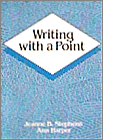 This is an excellent workbook that walks students through
the writing process, specifically in organizing and writing paragraphs, but the skills
learned then transfer easily to organizing and writing papers as well. We use this in the
second year of the dialectic in conjunction with Warriner’s to teach how to construct
well-written paragraphs. It covers Brainstorming and Observing, to teach finding something
to say, Catagorizing information once gathered (important for narrowing the focus of the
paragraph), Writing the Point [Topic] Sentence, Supporting the Point Sentence, Developing
the Paragraph, Improving Coherence, and Editing and Rewriting.
This is an excellent workbook that walks students through
the writing process, specifically in organizing and writing paragraphs, but the skills
learned then transfer easily to organizing and writing papers as well. We use this in the
second year of the dialectic in conjunction with Warriner’s to teach how to construct
well-written paragraphs. It covers Brainstorming and Observing, to teach finding something
to say, Catagorizing information once gathered (important for narrowing the focus of the
paragraph), Writing the Point [Topic] Sentence, Supporting the Point Sentence, Developing
the Paragraph, Improving Coherence, and Editing and Rewriting.
A Rulebook for
Arguments
Anthony Weston
 We use A
Rulebook for Arguments in the second half of the 8th grade to teach writing argumentative
paragraphs, and in the 9th grade to teach writing argumentative papers. In the 8th grade
we use chapters I-VI: Composing a Short Argument: Some General Rules; Arguments by
Example; Arguments by Analogy; Arguments from Authority; Arguments about Causes; and
Deductive Arguments. Then in the 9th grade we use chapters VII-X: Composing Argumentative
Essays: Exploring the Issue, Finding the Main Points of the Essay, Writing; and Fallacies.
We use A
Rulebook for Arguments in the second half of the 8th grade to teach writing argumentative
paragraphs, and in the 9th grade to teach writing argumentative papers. In the 8th grade
we use chapters I-VI: Composing a Short Argument: Some General Rules; Arguments by
Example; Arguments by Analogy; Arguments from Authority; Arguments about Causes; and
Deductive Arguments. Then in the 9th grade we use chapters VII-X: Composing Argumentative
Essays: Exploring the Issue, Finding the Main Points of the Essay, Writing; and Fallacies.
Return to Writing Index
Rhetoric Stage Writing: Grades 10-12
All three of the books below should be used in all three years of the rhetoric stage. Elements of Style and Style: Ten Lessons teach how to go beyond writing correctly and logically to writing clearly and elegantly. They will need to be referred to every time a child writes a paper. Warriner’s can be used to learn how to write a research paper, and will need to be kept on hand for reference after that.
Warriner’s
English Composition and Gammar
John Warriner

Warriner’s has a nice section on writing research papers, using research materials
and the library, using reference materials, taking notes, citing sources, etc. Once a
child learns how to write research papers, the best thing he can do is to practice writing
them, again and again. Warriner’s role throughout the rest of the rhetoric stage then
becomes as a handbook for reference.
Style: Ten Lessons in
Clarity & Grace
Joseph M. Williams
 This is a wonderful book that goes beyond teaching rules to really helping people learn to
write more clearly and, well, gracefully. The author says, “Getting beyond the trivia
and behind the self-evident has been the object of every edition of this book, so this
fifth edition still aims at answering these same three questions: What features in a
sentence determine how readers judge its clarity? How can you diagnose your own prose to
anticipate their judgments? How can you revise your prose so that your readers will think
well of it? ... this book is still not about writing; it is about rewriting. ...
there [are] a few good principles that I could rely on [in revising writing]. This book is
about those principles.” The ten lessons covered are: Understanding Style;
Correctness; Clarity of Actions (verbs); Clarity of Characters (subjects); Cohesion and
Coherence; Point of View; Emphasis; Concision; Shape; and Elegance. Invaluable.
This is a wonderful book that goes beyond teaching rules to really helping people learn to
write more clearly and, well, gracefully. The author says, “Getting beyond the trivia
and behind the self-evident has been the object of every edition of this book, so this
fifth edition still aims at answering these same three questions: What features in a
sentence determine how readers judge its clarity? How can you diagnose your own prose to
anticipate their judgments? How can you revise your prose so that your readers will think
well of it? ... this book is still not about writing; it is about rewriting. ...
there [are] a few good principles that I could rely on [in revising writing]. This book is
about those principles.” The ten lessons covered are: Understanding Style;
Correctness; Clarity of Actions (verbs); Clarity of Characters (subjects); Cohesion and
Coherence; Point of View; Emphasis; Concision; Shape; and Elegance. Invaluable.
The Elements of
Style
William Strunk, Jr. & E.B. White
 “Vigorous writing is concise. A sentence should contain
no unnecessary words, a paragraph no unnecessary sentences, for the same reason that a
drawing should have no unnecessary lines and a machine no unnecessary parts. This requires
not that the writer make all his sentences short, or that he avoid all detail and treat
his subject only in outline, but that every word tell.” --William Strunk, Jr. Making
“every word tell” is what The Elements of Style is all about. It covers:
Elementary Rules of Usage, Elementary Principles of Composition, A Few Matters of Form,
Words and Expressions Commonly Misused, and An Approach to Style. Continuously in print
since 1919, it is “Will Strunk’s parvum opus, his attempt to cut the vast
tangle of English rhetoric down to size and write its rules and principles on the head of
a pin.” --E.B. White.
“Vigorous writing is concise. A sentence should contain
no unnecessary words, a paragraph no unnecessary sentences, for the same reason that a
drawing should have no unnecessary lines and a machine no unnecessary parts. This requires
not that the writer make all his sentences short, or that he avoid all detail and treat
his subject only in outline, but that every word tell.” --William Strunk, Jr. Making
“every word tell” is what The Elements of Style is all about. It covers:
Elementary Rules of Usage, Elementary Principles of Composition, A Few Matters of Form,
Words and Expressions Commonly Misused, and An Approach to Style. Continuously in print
since 1919, it is “Will Strunk’s parvum opus, his attempt to cut the vast
tangle of English rhetoric down to size and write its rules and principles on the head of
a pin.” --E.B. White.
Return to Writing Index
Return to Catalog Index
![]()